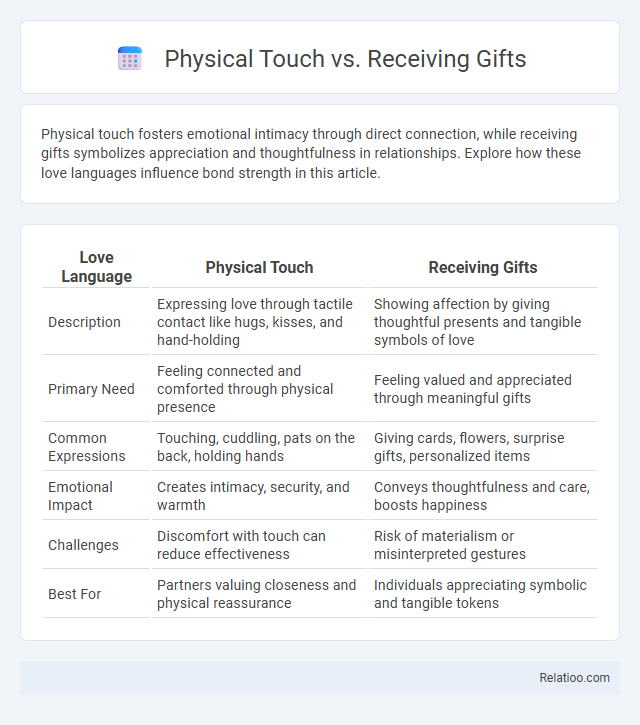Physical touch fosters emotional intimacy through direct connection, while receiving gifts symbolizes appreciation and thoughtfulness in relationships. Explore how these love languages influence bond strength in this article.
Table of Comparison
| Love Language | Physical Touch | Receiving Gifts |
|---|---|---|
| Description | Expressing love through tactile contact like hugs, kisses, and hand-holding | Showing affection by giving thoughtful presents and tangible symbols of love |
| Primary Need | Feeling connected and comforted through physical presence | Feeling valued and appreciated through meaningful gifts |
| Common Expressions | Touching, cuddling, pats on the back, holding hands | Giving cards, flowers, surprise gifts, personalized items |
| Emotional Impact | Creates intimacy, security, and warmth | Conveys thoughtfulness and care, boosts happiness |
| Challenges | Discomfort with touch can reduce effectiveness | Risk of materialism or misinterpreted gestures |
| Best For | Partners valuing closeness and physical reassurance | Individuals appreciating symbolic and tangible tokens |
Understanding Love Languages: Physical Touch vs Receiving Gifts
Understanding love languages is essential for nurturing relationships, as Physical Touch involves expressing affection through hugs, kisses, and hand-holding, which creates a sense of intimacy and security. Receiving Gifts communicates love by giving tangible tokens that symbolize thoughtfulness and appreciation, often resonating deeply when the gift reflects the recipient's desires or personality. Awareness of whether a partner values Physical Touch or Receiving Gifts allows couples to connect more meaningfully, meet emotional needs effectively, and strengthen their bond.
Defining Physical Touch as a Love Language
Physical Touch as a love language involves expressing affection through direct bodily contact, such as hugs, hand-holding, and gentle touches. This form of communication conveys emotional connection and reassurance, often fostering intimacy and trust in relationships. Unlike Receiving Gifts or verbal affirmations, Physical Touch emphasizes nonverbal signals that fulfill the innate human need for tactile closeness.
The Meaning Behind Receiving Gifts
Receiving gifts symbolizes thoughtfulness and value, reflecting the giver's effort and understanding of your preferences. It represents a concrete expression of love, creating lasting memories and emotional connections through tangible items. Your appreciation for receiving gifts reveals your desire for meaningful tokens that reinforce relationships beyond words.
Emotional Impact of Physical Touch in Relationships
Physical touch conveys deep emotional connection and fosters trust, releasing oxytocin that enhances bonding and reduces stress. Receiving gifts may symbolize thoughtfulness, but touch directly engages your senses, creating immediate feelings of safety and warmth. Prioritizing physical affection strengthens intimacy and emotional resilience in relationships by validating your partner's presence and care.
The Psychological Effects of Receiving Gifts
Receiving gifts triggers dopamine release in the brain, enhancing feelings of happiness and appreciation. This act reinforces social bonds by signaling care and attention, which can boost your overall emotional wellbeing. Unlike physical touch, gifts provide a tangible reminder of affection that can be revisited and cherished over time.
Advantages of Physical Touch for Connection
Physical touch enhances emotional bonding by releasing oxytocin, which strengthens trust and intimacy in relationships. You can experience immediate comfort and reassurance through hugs, hand-holding, or gentle touches, fostering deeper connection and reducing stress levels. Unlike receiving gifts or verbal affection, physical touch directly communicates care and presence, making it a powerful tool for strengthening your emotional ties.
The Significance of Gifts in Expressing Love
Gifts serve as tangible symbols of affection, offering a meaningful way to communicate love beyond words or physical touch. Unlike physical affection, which conveys intimacy through closeness, receiving gifts creates lasting memories and represents thoughtfulness tailored to the recipient's preferences. The significance of gifts in expressing love lies in their ability to encapsulate emotions, celebrate special moments, and reinforce emotional bonds through personalized gestures.
Challenges of Misaligned Love Languages
Misaligned love languages such as Physical Touch, Receiving Gifts, and Physical Affection can create significant challenges in relationships, often leading to feelings of neglect or misunderstanding. When Your partner values Physical Touch but you prefer Receiving Gifts, expressions of love may be misinterpreted or overlooked, causing emotional disconnect. Clearly communicating and recognizing each other's love languages is essential to bridge the gap and foster deeper emotional intimacy.
Balancing Physical Touch and Gift-Giving
Balancing physical touch and gift-giving enhances emotional intimacy by addressing different love languages and personal preferences. Physical touch offers immediate comfort and connection through hugs, hand-holding, or gentle touches, while thoughtful gifts symbolize appreciation and understanding over time. Integrating both approaches fosters a well-rounded expression of affection that resonates deeply in relationships.
Choosing the Right Love Language for Relationship Growth
Choosing the right love language for relationship growth involves understanding the unique needs of both partners, where physical touch, receiving gifts, and physical affection serve distinct emotional purposes. Physical touch fosters intimacy and reassurance through hugs or hand-holding, while receiving gifts symbolizes thoughtfulness and appreciation, often enhancing feelings of being valued. Prioritizing physical affection, such as cuddling or kisses, helps build emotional connection, making it essential to align expressions of love with your partner's preferred language for deeper bonding and sustained relationship satisfaction.

Infographic: Physical Touch vs Receiving Gifts
 relatioo.com
relatioo.com